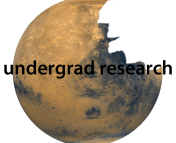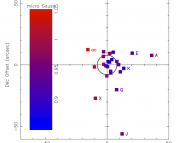 The undergrad research series is where we feature the research that you’re doing. If you’ve missed the previous installments, you can find them under the “Undergraduate Research” category here.
The undergrad research series is where we feature the research that you’re doing. If you’ve missed the previous installments, you can find them under the “Undergraduate Research” category here.
As we’ve entered back-to-school season now, many of you may have recently finished up REUs or summer research projects. We want to hear from you! Think you’re up to the challenge of describing your research carefully and clearly to a broad audience, in only one paragraph? Then send us a summary of it!
You can share what you’re doing by clicking on the “Your Research” tab above (or by clicking here) and using the form provided to submit a brief (fewer than 200 words) write-up of your work. The target audience is one familiar with astrophysics but not necessarily your specific subfield, so write clearly and try to avoid jargon. Feel free to also include either a visual regarding your research or else a photo of yourself!
We look forward to hearing from you!
************
Alex Deich
Alex is a physics major at Reed College in Portland OR. He’s working on data from the VISTA Variables in the Via Lactea (VVV) survey, from the VISTA 4m telescope in Paranal, Chile with Alejandre Roman at the Universidad de La Serena, Chile, and Andrea Kunder at CTIO.
Open Clusters in the Galactic Bulge
Open clusters are groups of about a thousand stars that were all born of the same molecular cloud. With relatively little gravitational attraction, open clusters tend to last for only hundreds of millions of years, rather than the billions that globular cluster do.
Because the constituents are all relatively recent siblings (and have accordingly similar ages and compositions), open clusters are important for the study of stellar evolution, as their properties can be more easily determined than solitary stars. Their study requires good photometry and well-optimized clustering algorithms, which are fascinating: http://en.wikipedia.org/wiki/Cluster_analysis.
The VVV survey is a public survey of the galactic bulge in the near-IR with J, H, and Ks images available. It can provide excellent photometry of wide fields, and is proving extremely useful in the search for large structures, like open clusters. This paper presents color-color and color-magnitude diagrams of three new open clusters found with photometry from the newly released VVV-SKz photometry pipeline. This pipeline, developed at the Universidad de Concépcion, provides extremely accurate photometry for the VVV data set. Finally, the paper explores for the first time various clustering algorithms and their use with VVV data.
************
Merrill Butler III
Merrill is a member of NITARP, which is a program that teaches teachers — and, in Merrill’s case, an amateur astronomer — how to conduct astronomical research using archived data from Spitzer, WISE, Galex and other space telescopes.
Discovery of Galactic Clusters at z=1
We propose to study galaxy clusters around Active Galactic Nuclei (AGN) at a high redshift range of 0.7 <z<1.2. In order to accomplish this we utilized data from the Spitzer Space Telescope compiled by Falder et al. We identified galaxy clusters by using simple IRAC color selection which has been found to be effective at unraveling high redshift galaxies (A. Galametz et al. 2011). Using a counts-in-cell analysis, we identified fields that were over dense with 15 or more IRAC sources within 1′ ( ie., 0.5 Mpc at 1<z<3) of the targeted galaxy to the 5 sigma flux density limits of the IRAC that was targeted. The number of the sample is 168 and we have discovered new galaxy cluster candidates. We are also created statistical sampling confirming suggestions that high redshift radio AGN with high radio luminosity lie in some of the densest regions of the Universe.



